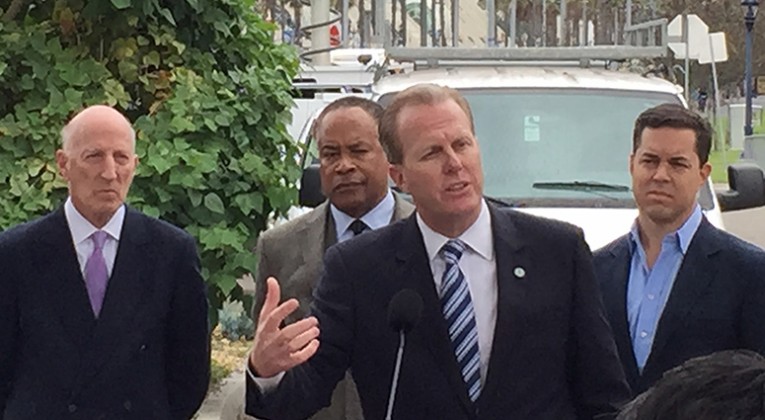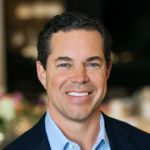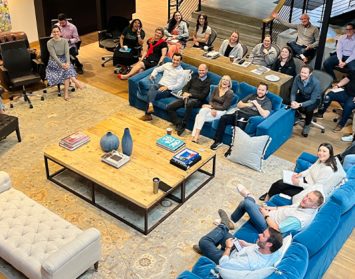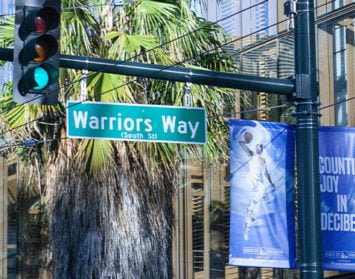Civic leaders will recommend location, financing plan for new stadium
By David Garrick
DOWNTOWN SAN DIEGO — Mayor Kevin Faulconer unveiled a new nine-member stadium task force on Friday that includes financial experts, prominent developers, longtime government leaders and a former Chargers executive.
Faulconer said he tried to select a small and diverse group with the skills and experience to develop large-scale projects and the financing plans needed to get them built.
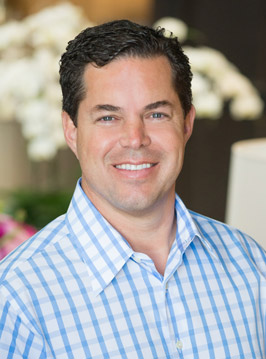
“This well-rounded group will be nimble enough to complete an analysis, develop plans and make recommendations by the fall of this year,” Faulconer said during a news conference next to Petco Park.
The plans will include where to build a stadium — on the current Mission Valley site or downtown as part of a convention center expansion — and how to pay for it, the mayor said.
The task force, called the Citizens’ Stadium Advisory Group, includes construction magnate Doug Barnhart, longtime county chief executive Walt Ekard, commercial real estate expert Jason Hughes and Jim Steeg, who was the Chargers’ chief operating officer from 2004 to 2010.
Faulconer said Steeg would play a key role in helping the task force analyze how funding was secured in recent years for new NFL stadiums in San Francisco, Dallas, Phoenix, Minneapolis and Indianapolis.
“They all have different models of how they financed it and put it together,” said Steeg, who’s been known more for planning events like the Super Bowl than for stadium construction so far in his career. “I think you steal a little of this and a little of that.”
The other task force members are investor Rod Dammeyer, energy executive Jessie Knight, urban planner Mary Lydon, Sycuan tribal official Adam Day and Aimee Faucett, chief operating officer of the San Diego Regional Chamber of Commerce.
Friday’s announcement was greeted with measured responses by those who criticized the mayor for announcing two weeks ago that another task force was his solution to the longtime problem of the Chargers needing a new stadium.
City Councilmen David Alvarez and Todd Gloria initially called the plan too passive, with the threat of the team moving to Los Angeles looming steadily larger.
But both politicians expressed hope on Friday that the task force could succeed.
“I look forward to hearing the recommendations of this latest task force and hope to be able to discuss a specific proposal soon,” Alvarez said.
Mark Fabiani, special counsel to the Chargers, expressed little enthusiasm but said in a prepared statement that the team would be “pleased to evaluate” the ideas generated by the group.
Two weeks ago, Fabiani criticized the mayor, complaining that a similar effort launched in 2003 failed to yield a new stadium and that more analysis wasn’t the answer.
San Diego hotelier Bob Rauch called the group solid, but said he would have preferred to see an attorney and an economic analyst included.
“I don’t see that we have a sharp attorney to refute (lawyer) Cory Briggs’ likely lawsuits or any concerns that an obstructionist might have,” Rauch said.
Briggs, who has filed multiple lawsuits in recent years that have stymied city plans, declined to comment on the task force on Friday and said he couldn’t predict whether he will file any lawsuits until he sees a proposal.
“The devil is in the details,” he said.
Faulconer strived on Friday to differentiate this task force from previous efforts to build a new stadium since the Chargers declared Qualcomm Stadium unacceptable more than 13 years ago.
Those efforts were more open-ended, involved more people and only produced renderings and financing ideas, the mayor said.
“A plan is when somebody tells you this is where it’s going to go, this is how we’re going to build it and, most importantly, this is how it’s going to be paid for,” said Faulconer, stressing that the new task force will produce something tangible and complete.
Faulconer said he also expects the task force to help create consensus about how best to build a stadium many months before a possible public vote on the proposal in November 2016.
“San Diegans are going to be able to see it, feel it, kick the tires and, in the end, voters will have the final say,” the mayor said.
The financing plan is expected to play a huge role in the proposal’s fate at the polls, with increases in local taxes requiring two-thirds approval from voters.
Faulconer said the proposal must be “a good and fair deal for San Diego taxpayers,” but he hasn’t specified what kind of contributions from the city, in either land, resources or money, he would support.
He said Friday he’s open to some sort of joint financing agency with the county, selling naming rights, selling revenue bonds, having fans pay seat licenses and other options.
Members of the task force declined to specify on Friday what financing they could support, but they expressed enthusiasm and confidence about the process.
Day said he was honored to be chosen.
“It’s exciting to be part of an effort that could solve the leading public policy question of the last 20 years,” he said, predicting the group would succeed. “Frankly, it’s not rocket science. We need to pick a site and we need to develop a plan that makes sense to everyone involved.”
Faucett, another member, praised the mayor for bravely tackling a complex problem.
“It would be easy not to take on the stadium issue, but it wouldn’t be right,” she said.
Faulconer said the task force will elect a chairman at its first meeting and decide how often to meet.
While no one from the Chargers is on the panel, Faulconer said the team would interact with the group, with both probably making presentations to each other.
In Fabiani’s statement, he said the Chargers would cooperate with the task force but noted they’ve been down this path several times.
“We will be happy to share with the mayor’s new task force the nine different stadium proposals the Chargers have made over the years, as well as the ideas produced by another city-appointed task force and by two separate outside experts hired by the city,” he said.
This article originally appeared in U-T San Diego.
Jason Hughes is founder of Hughes Marino, an award-winning commercial real estate company with offices across the nation. A pioneer in the field of tenant representation, Jason has exclusively represented tenants and buyers for more than 30 years. Contact Jason at 1-844-662-6635 or jason@hughesmarino.com to learn more.

